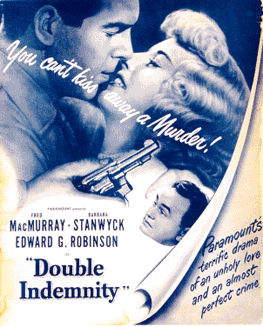
“One of the highest summits of film noir…
without a single trace of pity or love.”
– Charles Ingham, 1971
Double Indemnity, Billy Wilder’s classic proto-noir from the pot-boiler novella by James M. Cain, is a great melodrama with snappy dialog and a tight script from Wilder and Raymond Chandler. All the elements of the archetypal film noir are distilled into a gothic LA tale of greed, sex, and betrayal. The casting of the inscrutable Fred MacMurray as the anti-hero, a seductive and transparently vile Barbara Stanwyck as the femme-fatale, and Edward G. Robinson as the garrulous claims manager is inspired.
I have lost count of how many times I have watched this movie, and it has been over 30 years since I first saw it on TV as teenager, but with each viewing I come away with something new. It attests to Wilder’s skill as a film-maker that the dramatic tension is sustained until the last frame even though the whole story is told in flashback – we know Walter Neff is a goner from the go. The opening fluid shots of the wounded Neff’s car careening down the dark LA streets with Miklos Rosza’s musical counterpoint, wonderfully establish the dark dramatic mood before any character is seen on the screen.




But there are some nagging weaknesses. The only rounded character is Robinson’s claims manager, Barton Keys. Walter Neff and Phyllis Dietrichson are flat protagonists and our interest is sustained mostly by their early banter and poisoned repartee in the brutal climax. Neff says he loves Phyllis, but I all I see is a murderous conspiracy based on greed and lust. He has no real remorse and elects to clean up the unravelling of the crime by plugging Phyllis – despite her last minute conversion. Half-way through, the picture is nearly lost by the over-long and ludicrous scene in the office of Barton Keys’ boss, who is played so badly that the otherwise deft attempt at comic relief falls completely flat – I was reminded of Zeppo Marx…
That said, Double Indemnity is great entertainment and a recommended introduction to the film noir genre.
![]()

wilder was no joke and double indemnity was genius
LikeLike
Hi! Tony…
Here Goes A Story Straight Out Of LaLa Land…Now if this isn’t a story about “life” imitating “art” are I don’t what else is?!?…creepy! 😕
DeeDee 😉 😦
LikeLike
“Now if this isn’t a story about “life” imitating “art” [are] I don’t what else is?!?”
Oops! 😳 I didn’t mean to include the word “are” in my comment and yes, the link do link back to my administrator’s Ning.
LikeLike
Indeed DeeDee!
LikeLike
Have to admit, I cringed when this movie was associated with the term “weaknesses”. I love this film. I think the fact that the two characters don’t really like each other, yet are planning murder is sort of a fascinating take on the human condition. But I bow to your expertise. It was indeed my introduction to film noir, and really to old films period. Flipping through channels 10 years ago, saw this on cable. Became enthralled enough that I turned it off after 10 minutes – so I could later watch from the beginning. The dialogue and voice over narration is just sublime- that paranoid bit about how Neff started “wearing dark glasses to keep a low profile, then got to worrying people would wonder why he was wearing them” just gets me. Doesn’t get more noir than that.
LikeLike
Hey Lee. Perhaps I am a bit finicky on my identification of “weaknesses”, and really my opinion is no better or more informed than the next guy’s. I can be eccentric to say the least -:) So no need for bows. It is Raymond Chandler’s dialog that gives Double Indemnity its power and elevates it to something greater than Cain’s novel. Great to have your contribution.
LikeLike